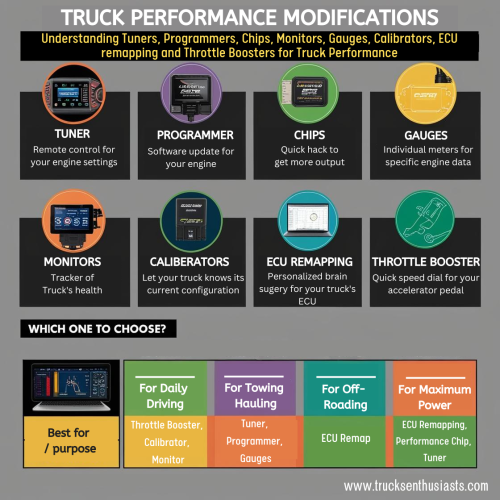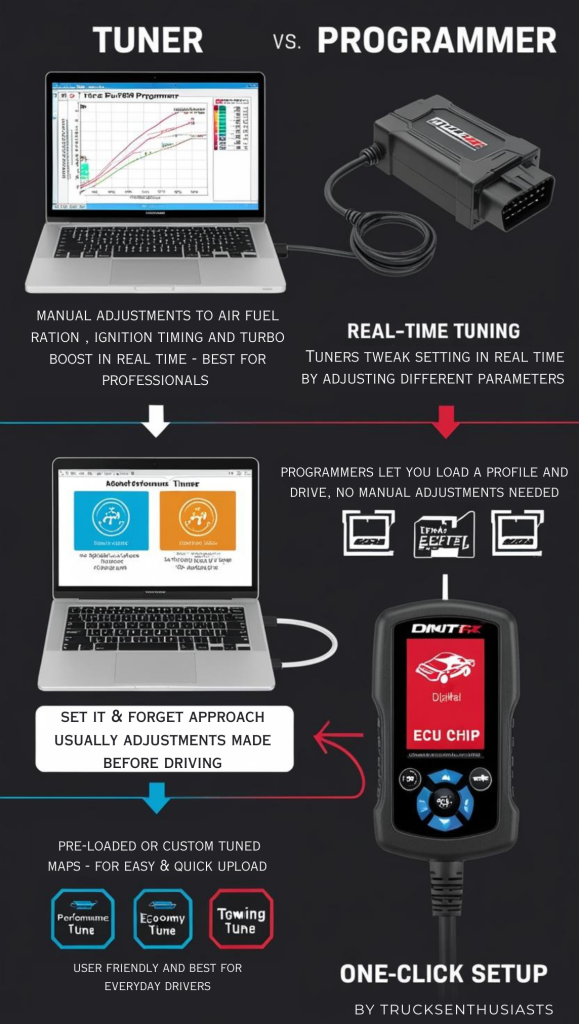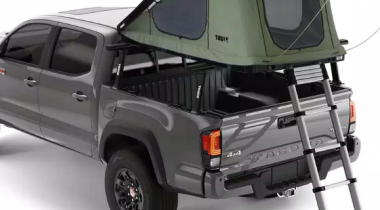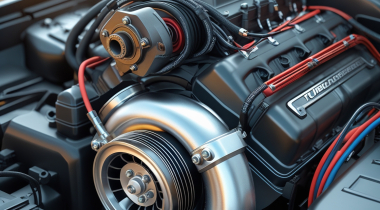Understanding Tuners, Programmers, Chips, Monitors, Gauges, Calibrators, and Throttle Boosters for Truck Performance

When it comes to upgrading your truck’s performance, the market is overflowing with tools and devices, each promising better power, efficiency, or control. But here’s the catch: which one should you choose?
You’ve probably heard terms like tuners, programmers, chips, monitors, gauges, throttle boosters, and accelerators. Each of these serves a unique purpose, yet it’s easy to get confused in trying to figure out:
- Which one boosts horsepower?
- Which one is for monitoring the engine’s health?
- Which one fine-tunes your truck for maximum output?
- Are they all the same, or do they serve different roles?
I’ve been in the same boat—confused and unsure which performance module would best suit my truck. But after diving deep into how these tools operate, their specific functions, and their ideal use cases, I finally understood what sets them apart and how to choose the right one for any goal.
If you’re facing the same confusion, don’t worry—you’ve landed in the right place. In this article, I’ll break down:
- What each performance module does
- The purpose it serves
- When you should use it
- Real-world examples for clarity
By the end, you’ll have a clear understanding of which module is the perfect fit for your truck’s needs. This guide might get a bit lengthy, but I promise one thing: by the end, all your doubts about tuners, programmers, chips, and similar devices will be cleared from the ground up.
If you find this guide helpful, don’t forget to share it on social media and subscribe to our mailing list for more truck performance tips and updates.

Let’s dive in, one module at a time!
1. Tuners (Remote control for your engine settings)
Purpose:
Ignition timing : The second most common purpose of a tuner is controlling ignition timing, which primarily determines when the spark plug fires during the engine’s combustion cycle. Proper adjustment can lead to better fuel efficiency, smoother acceleration, or increased power, depending on your specific needs. Precise timing delivers optimal results.
Turbo Boost : This is primarily for trucks equipped with a turbocharger. A tuner helps control the turbo boost, balancing turbo operation while ensuring engine safety, as increased boost can strain the engine.
How it works:
A tuner connects to your truck’s ECU (Engine Control Unit), usually through the OBD-II port under the dashboard. This connection allows the tuner to read the engine’s existing software settings, which control things like fuel delivery, ignition timing, turbo boost, and throttle response.
Once connected, the tuner uses special software to modify these settings—a process called remapping or tuning. For example, it might increase fuel flow, adjust turbo pressure, or change how the throttle responds to your foot. After making these changes, the tuner uploads the new settings back into the ECU.
This process helps optimize your truck for more power, better fuel efficiency, or improved towing performance. If needed, you can usually revert to the original settings saved during the initial connection.
Best For: Increasing horsepower, torque, and fuel efficiency.
When to Use: Ideal for trucks needing overall engine optimization (e.g., after engine upgrades like a turbo or exhaust system).

Popular Tuners in market: Superchips/flashpaq, Bully Dog, DiabloSport tuner.
Performance Gains with Tuner: You can expect an HP gain anywhere between +10–200 and up to 220 lb-ft of torque, along with a 1–5 MPG improvement, depending on your engine size, design, tuning software quality, and any other modifications. Check out this article to understand Typical Performance Gains with a Tuner: NA vs. Turbocharged Engines Explained.
Example Scenario: How a Tuner Helps
Imagine you’ve installed a bigger turbocharger on your Toyota Hilux truck. The factory ECU settings don’t know how to handle this upgrade. A handheld tuner lets you adjust the fuel delivery, ignition timing, and boost pressure to make sure your engine runs smoothly and takes full advantage of the new turbo.
2. Programmers (Software update for your engine)
Purpose:
A programmer essentially reprograms the ECU with pre-loaded maps or custom-tuned maps. It typically comes with a set of pre-configured maps designed for specific tasks, such as:
- Performance Mode: For maximum horsepower.
- Tow Mode: For heavy hauling.
- Economy Mode: For better fuel efficiency.
The programmer recalibrates or re-uploads these maps to your engine’s existing settings, making it run like new.
Some programmers also allow you to upload custom maps, specifically tailored for your truck’s modifications (like a larger turbo or an upgraded exhaust system). These maps are usually designed by professional tuners and then uploaded via the programmer.
How it works:

A programmer connects to your truck’s ECU (Engine Control Unit), usually through the OBD-II port just like tuner. Once connected, the programmer reads the current engine settings stored in the ECU. These settings are organized into maps, which are like digital instructions telling your engine how to perform under different conditions.
The programmer then modifies these maps—a process called remapping—to optimize your truck for better power, fuel efficiency, or towing performance and after these changes uploads the new maps back into the ECU.This process helps fine-tune your truck’s performance based on your driving needs. The best part? Many programmers allow you to save your original factory settings, so you can restore them anytime if needed.
But you might think this looks similar to how a tuner operates. So, what’s the difference?
Tuners are designed for professionals who can tweak settings in real-time while the truck is running or have a solid understanding of engine tuning and parameter adjustments. On the other hand, programmers work with custom or pre-loaded tunes, allowing you to simply load a profile and start driving without needing to manually adjust any settings. This makes programmers perfect for users with less technical knowledge who still want noticeable performance improvements
Best For: Versatile performance needs, including towing, fuel economy, or raw power.
When to Use: After major engine upgrades or when you want specific performance profiles or custom made tunes. After installing a new exhaust , new turbo , bigger tires or if you want more performance for long trips.
Popular Tuners in market: Edge Products. , Edge Pulsar programmer,Hypertech max Energy
Example Scenario: How a Programmer Helps
Imagine you’ve upgraded your Ford Superduty with a high-performance exhaust system and larger all-terrain tires. The stock ECU settings won’t know how to fully utilize these changes. A programmer allows you to upload a custom map optimized for these upgrades. Now, your engine knows how to deliver the right power, fuel efficiency, and torque balance to make the most of your modifications.
Lastly : A programmer is like giving your truck an advanced performance brain transplant. It doesn’t just tweak settings—it can completely transform how your truck behaves based on your driving needs. Whether you’re towing, cruising, or off-roading, a programmer ensures your ECU is always in sync with your goals.
3. Performance Chips (Quick hack to get more output)
Purpose:
The performance chip works similarly to a tuner, but in a less complicated way. It basically override or manipulates the ECU’s signals to get desired output. For example, it adjusts how much fuel is delivered to the engine under specific driving conditions.
- More fuel = More power
- Less fuel = Better efficiency
It can also increase boost pressure, allowing more air into the engine, which results in higher power output. Additionally, a chip helps reduce lag between pressing the gas pedal and the truck responding, leading to quicker acceleration and smoother throttle control.
These adjustments act as instant tweaks for immediate results. Performance chips are typically easy to use, require minimal setup, and are more affordable compared to tuners or programmers.
How it works:
Performance chips are small devices that plug directly into your truck’s ECU (Engine Control Unit), usually through the OBD-II port or by connecting to specific engine sensors.
Unlike tuners or programmers, performance chips don’t reprogram the ECU. Instead, they trick or override certain signals going to and from the ECU.
For example, they might adjust the readings from the airflow sensor or fuel injectors to make the engine run with a richer fuel mixture, increase turbo boost pressure, or tweak ignition timing. This tricks the ECU into making real-time adjustments to improve horsepower, torque, or fuel efficiency.
The chip works passively, continuously feeding these modified signals while the engine is running, and doesn’t permanently change the ECU’s original programming. It’s typically a plug-and-play solution, requiring minimal technical knowledge to install and use.
Best For: Quick horsepower and torque gains without deep ECU adjustments.

When to Use: If you’re finding Budget-friendly option and easy upgrades for quick gains. You can use it for quick power boost, or even after light upgrades like CAI or new exhaust or most commonly in reducing throttle lag.
Popular Chips in market: Jet Performance, Superchips.
Example Scenario: How a Performance Chip Helps
Imagine you’re driving your Ram 2500 with a fully loaded trailer on a steep hill. Without a performance chip, your engine might struggle to maintain power. With the chip installed, your ECU is tricked into sending more fuel to the engine and boosting turbo pressure, giving you the extra power you need to climb effortlessly.
lastly -A performance chip is like a quick performance boost button for your truck. It’s easy to install, affordable, and delivers immediate results. While it doesn’t offer the fine-tuning capabilities of a programmer or tuner, it’s an excellent choice for truck owners who want a simple, effective way to increase power, throttle response, or fuel efficiency.
4. Performance Monitors ( Tracker of Truck’s health )
Now, let’s move on to our next device: the Performance Monitor. So far, we’ve talked about tools that modify, tweak, or completely reprogram the ECU settings to boost performance. However, the Performance Monitor is entirely different—its primary role is not to change anything but to observe and display real-time engine data.
In simple words, a Performance Monitor is like having a health tracker for your truck’s engine. While tuners, programmers, and chips focus on changing engine settings for better performance, a Performance Monitor doesn’t make any changes. Instead, it focuses on observing, analyzing, and displaying real-time engine data so you can see exactly what’s happening under the hood while driving.
Purpose: Display real-time data about engine performance and diagnostics.
Real-time reporting: The primary function of a performance monitor is to create awareness for the driver and inform them whenever an issue arises with basic engine parameters. Its main role is to provide a real-time report of the engine’s operation.
How it works:
Best For: Monitoring engine performance, identifying problems, fine-tuning settings, understading your engine with more detailed information (not just vague dashboard lights) because with Monitor you get to know what is actually not right like it tells you if your Coolant temperture is too high not just flashing a light.
When to Use: When you want to monitor performance after upgrades.During daily driving , after installing performance upgrades (eg. CAI , exahust or turbo) to check whether if those are working fine or not. Also while towing or Off-roading to montior curical engine parameters. Or when you’re really facing some issues, that time you can use it to diagnose actual problem.
Popular monitors in market: Edge Insight CTS3, Diablosport monitor
Example Scenario: How a Performance Monitor Helps
Imagine you’re towing a heavy trailer uphill, and you notice your engine temperature rising on the monitor. Before it gets dangerously high, you can pull over, let the engine cool down, and prevent severe damage. Without a monitor, you might not notice the problem until the check engine light flashes—and by then, it could already be too late.
Lastly– The primary function of a performance monitor is to create awareness for the driver and inform them whenever an issue arises with basic engine parameters. Its main role is to provide a real-time report of the engine’s operation.This data helps you understand how your engine is performing and allows you to identify potential issues before they become serious problems.
5. Gauges (Individual meters for specific engine data)
Purpose:
The purpose of gauges is similar to that of a monitor—to display and monitor real-time data and send instant alerts to help prevent engine damage. However, the key difference is that gauges are designed to focus on one specific parameter per device.
For example:
- A Turbo Boost Pressure Gauge shows how much air pressure your turbo is producing.
- An Oil Pressure Gauge monitors whether the engine is receiving adequate oil flow.
- An Exhaust Gas Temperature (EGT) Gauge tracks how hot the exhaust gases are.
- A Coolant Temperature Gauge keeps an eye on the engine’s cooling system.
Like monitors, gauges also send instant alerts to the driver, allowing them to take action before any significant engine damage occurs.
How it works:
Gauge is phycial device installed in your truck. It connects to the truck’s ECU (Engine Control Unit) or directly to specific sensors in the engine.
As the engine runs, the gauge reads live data from these sensors and displays it instantly on its screen or dial. This allows drivers to keep a close eye on critical engine functions while driving, ensuring everything is operating within safe limits.
For example, a boost gauge will show how much pressure the turbocharger is generating in real-time, helping you spot issues like over-boosting or pressure drops. Gauges are simple, focused, and reliable tools for monitoring vital engine health and performance.
Best For: Drivers who need to monitor specific parameters for safety or performance. Also best for those who are looking for budget friendly option then montiors.Also helps you create customize dashboard by installing mulitle gauges.
When to Use: Essential for performance driving (EGT guage), off-roading (Oil temperature and Coolant guage), or heavy towing (oi pressure guage) or after installing a Turbocharger (boost guage)
Popular guages in market: AutoMeter, GlowShift.
Example Scenario: How Gauges Help
Imagine you’re towing a heavy trailer uphill, and your EGT (Exhaust Gas Temperature) gauge starts climbing into the red zone. You immediately know that your engine is working too hard, and it’s time to ease off the throttle or stop for a cooldown. Without this gauge, you might not notice until serious damage occurs.
Lastly – Gauges are like having individual health monitors for your truck’s most important systems. They provide live, focused data that can mean the difference between catching a problem early or facing expensive repairs later.
6. Calibrators (Let your truck knows its current configuration)
Purpose:
A calibrator, in simple terms, adjusts specific signals in your truck’s ECU based on your driving requirements or installed upgrades. There are different types of calibrators, each designed for specific needs or modifications.
For example, when you install larger tires or change the gear ratio, your speedometer readings can become inaccurate because the ECU isn’t aware of the changes. A speedometer calibrator fixes this by adjusting the readings to match your truck’s actual speed.
Similarly, bigger tires can affect your odometer readings, causing it to miscalculate distance traveled. A calibrator also corrects these odometer settings to ensure accurate tracking.
In essence, a calibrator reprograms sensor settings to ensure that your truck’s speedometer, odometer, and other critical readings remain precise and reliable after upgrades.
Aditional purpose : Moreover, it also adjusts transmission shift points to match your upgraded setup, ensuring smooth gear changes.
You might have noticed that sometimes your engine triggers false warning lights after certain upgrades. In such cases, the calibrator steps in to clear unnecessary warning codes caused by hardware changes.
While it’s generally not advisable to ignore these warning lights, if you’ve already installed a monitor or gauges that provide you with a real-time picture of your engine’s health, there’s no need to stress over false alarms.
How it works:
Best For: Ensuring accuracy after suspension lifts, gear swaps, or tire size upgrades. Even best for you if you’re looking budget friendly option to tune your truck as per your upgrades.
When to Use: After any physical changes to drivetrain or tire size or after installing suspension lift kits. For changing gear ratio or even clear false warning signals.
Popular caliberators in market: Hypertech Speedometer Calibrator, Superchips Flashcal.
Example Scenario: How a Calibrator Helps
Let’s say you upgraded your Toyota Tacoma with bigger off-road tires and a new gear ratio to handle rough terrains better. After the upgrade, you notice your speedometer says 60 mph, but you’re actually going 70 mph. This happens because the ECU wasn’t designed for those bigger tires. A calibrator allows you to adjust the speedometer settings, ensuring that your readings are accurate and your truck behaves correctly.
Lastly -A calibrator might not sound as flashy as a tuner or programmer, but it’s an essential tool when making drivetrain upgrades. It ensures your truck’s ECU understands and adapts to changes like bigger tires or gear swaps, preventing inaccurate readings and costly damage over time.
Whether you’re a daily driver, an off-road enthusiast, or someone who just loves tinkering with their truck, a calibrator is your go-to tool for precision adjustments.
7. Throttle Boosters (Throttle Response Controllers- Quick speed dial for your accelerator pedal)
Throttle boosters or throttle response controllers—as the name suggests—are designed to enhance your vehicle’s throttle response, and that’s exactly what they do. These devices improve how quickly your truck responds when you press the accelerator pedal, eliminating lag and delivering quicker acceleration.
A throttle booster, also known as a throttle response controller, is like giving your truck’s gas pedal a caffeine shot. Its main job is to improve how quickly your truck responds when you press down on the accelerator pedal, eliminating that annoying acceleration lag you often feel in modern vehicles with electronic throttle systems.
Purpose:
The main purpose of a throttle booster is to eliminate throttle delays. In simple terms, it makes your truck respond immediately when you press the gas pedal.
You might have noticed this delay, especially in newer trucks, where pressing the gas pedal doesn’t result in an instant engine response. This is where the throttle booster comes into play.
Buy Why Throttle lag at First – “You might wonder why throttle lag exists at all. In older trucks, throttle lag is common due to wear and tear in mechanical components. However, even in modern trucks, throttle lag can still occur because of electronic throttle control (drive-by-wire systems). This lag is usually caused by a delay in signal processing between the accelerator pedal sensor and the ECU (Engine Control Unit). Additionaly ,Manufacturers sometime programs throttle response to be less aggressive to meet the emmission standards and which is good also to get better fuel efficiency and smoother driving expericnce.”
So, overall It enhances the acceleration rate, making your truck feel quicker and more powerful without requiring any engine upgrades.
How it works:

A throttle booster or throttle response controller is typically attached to the accelerator pedal sensor in your truck. Most modern trucks use an electronic throttle control (drive-by-wire system), where the pedal sensor sends signals to the ECU (Engine Control Unit). The throttle booster plugs directly into the accelerator pedal’s wiring harness, acting as a middleman between the pedal and the ECU.
The accelerator pedal doesn’t directly control the throttle body; instead, it sends an electronic signal to the ECU, which then adjusts the throttle opening. This system can cause a slight delay, known as throttle lag. A throttle booster acts as a middleman between the pedal and the ECU, amplifying and refining the signal from the pedal.
When you press the accelerator, the booster sends a faster and sharper signal to the ECU, reducing the delay in throttle response. Essentially, it tricks the ECU into thinking you’ve pressed the pedal harder or faster than you actually have. This results in quicker acceleration, faster engine response, and eliminates that sluggish feeling when you step on the gas.
Best For: Drivers who want instant throttle response without waiting for turbo spool-up.
When to Use: Ideal for city driving, off-roading, or towing situations requiring quick acceleration.
Popular throttle boosters in market: Pedal Commander, K&N Throttle controler
Example Scenario: How a Throttle Booster Helps
Imagine you’re driving your Chevy Silverado up a steep hill with a heavy trailer attached. You press the gas pedal, but there’s a noticeable delay before the engine reacts. With a throttle booster installed, that lag is eliminated. The engine responds instantly to your input, giving you the power and control needed to climb the hill without hesitation.
Lastly – A throttle booster is one of the simplest and most effective upgrades you can make to your truck. While it doesn’t add horsepower, it unlocks your engine’s potential by delivering power instantly when you press the gas pedal. So, If you’re tired of that sluggish throttle response and want instant, snappy acceleration, a throttle booster is the perfect upgrade for your truck.
8. ECU Remapping (Personalized brain sugery for your truck’s ECU)
Purpose:
ECU remapping is undoubtedly one of my favorite ways to upgrade a truck’s performance, but I wouldn’t recommend it unless you’re a serious enthusiast with a heavily modified truck.
It’s not just a simple tweak—it’s a complete transformation of your truck’s ECU (Engine Control Unit), unlocking immense potential for performance gains.
With ECU remapping, you can:
- Optimize Fuel Injection: Adjust how much fuel is injected into the engine and when it’s delivered for maximum power or efficiency.
- Control Turbo Boost: Fine-tune the turbo boost pressure to deliver exactly the amount of power you need.
- Adjust Ignition Timing: Modify when the spark plug fires to achieve the perfect combustion cycle for increased efficiency and power.
- Enhance Throttle Response: Eliminate throttle lag, ensuring instant acceleration when you press the pedal.
- Custom Calibration for Upgrades: Align settings for aftermarket mods like bigger turbochargers, upgraded exhaust systems, or high-flow fuel injectors.
What sets ECU remapping apart is that it’s not just a device—it’s a professional process. It’s like giving your truck’s ECU a complete brain surgery, combining the benefits of tuners, programmers, chips, throttle boosters, and calibrators—all in one package.
These are some of the common examples , the possibilities are virtually endless:
- You can increase your truck’s top speed.
- Remove factory-set RPM limits.
- Fine-tune every parameter to suit your specific driving style or performance needs.
In short, ECU remapping is not just an upgrade—it’s a complete overhaul of your truck’s electronic brain, ensuring it performs exactly how you want it to.
How it works:
The remapping process starts by connecting a laptop or tuning device to the truck’s OBD-II port (usually under the dashboard) or, in some cases, directly to the ECU if deeper access is needed.
Once connected, the tuner downloads the existing ECU software, which contains settings for fuel delivery, air-to-fuel ratio, turbo boost pressure, and ignition timing. These settings are then modified using specialized software to optimize them for specific goals, like more power, better fuel economy, or smoother towing.
Once the adjustments are complete, the new software is uploaded back into the ECU. From that point on, the ECU follows these updated instructions, sending refined signals to components like fuel injectors, turbochargers, and ignition systems. The result is increased horsepower, better torque delivery, improved throttle response, and, in some cases, better fuel efficiency.
Remapping is essentially like giving your engine a custom performance blueprint tailored to your driving needs.

Best For: Professioanl tuning , Trucks with significant modifications (e.g., upgraded turbo, intercooler, or fuel injectors).
When to Use: When off-the-shelf solutions (like tuners) aren’t enough or when installing major upgrades where tuners or any other device is not enough to give your desired output. You can expect better long term results with ECU remapping.
Popular ECU remapping tuners in market: HP Tuners MPVI3, Launch X4i Pro3S, Cobb Tuning.
Example Scenario: How ECU Remapping Helps
Imagine you’ve upgraded your Ford F150 with a larger turbo, high-performance exhaust, and better intercoolers. Without ECU remapping, your truck’s ECU won’t understand how to balance the increased air intake, fuel flow, and exhaust output.After ECU remapping, every setting—fuel injection timing, turbo boost pressure, and air-to-fuel ratio—is fine-tuned to ensure optimal performance, efficiency, and engine safety.
The result? More horsepower, better throttle response, smoother driving, and improved fuel economy.
lastly – ECU Remapping isn’t just about tweaking numbers—it’s about rewriting your truck’s DNA to match your driving goals and hardware upgrades. While it’s more technical and usually requires a professional tuner, the results are undeniably worth it—your engine will perform smoother, stronger, and smarter.
Which One Should You Choose?
Choosing between these 8 performance devices—Tuners, Programmers, Chips, Performance Monitors, Gauges, Calibrators, Throttle Boosters, and ECU Remapping—comes down to your truck’s setup, your driving goals, and your budget.
Pro Tips for Choosing the Right Tool:
- For Daily Driving: Throttle Booster, Calibrator, Monitor
- For Towing/Hauling: Tuner, Programmer, Gauges
- For Off-Roading: Snorkel, Lift Kits, ECU Remap
- For Maximum Power: ECU Remapping, Performance Chip, Cold Air Intake
Conclusion
Every tool has its purpose, and the right choice depends on your driving style, needs, and budget. For minor tweaks, a chip or throttle booster will do the job. For serious upgrades, consider tuners, ECU remaps, programmers and performance monitors.
Choosing the right tool isn’t just about adding power—it’s about unlocking your truck’s full potential, enhancing driving experience, and protecting your investment in the long run.
So, match the right tool with your truck’s needs, and you’ll unleash the full power of your beast—turning every drive into an unforgettable adventure!
Need help picking the right upgrade? Let me know, and I’ll guide you further!

Vicky Dwaj, Founder and CEO of TrucksEnthusiasts , is an automobile engineer passionate about pickup trucks and accessories. Follow his journey to discover the latest trends in off-road accessories, cars, and truck parts.







